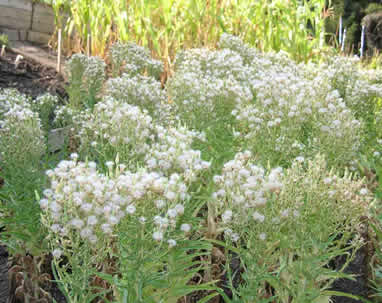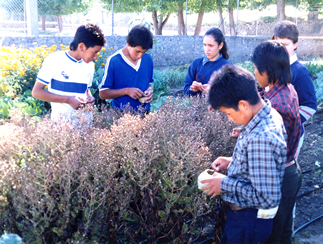Principle 7:
Open Pollinated Seeds
Goal: Maximize seed production and
quality and preserve genetic diversity
Using open-pollinated (OP) seeds allows the farmer to save seeds on the farm, providing for future crops through growing healthy, locally acclimatized, fresh seeds. This helps create a self-sufficient closed system by reducing dependence on large or small seed vendors, and by saving money. It is generally possible to grow all the seeds necessary for next year’s garden in about 3% additional area.
Seed savers must start with OP seeds. This is because hybrid seeds have been crossed already, and do not have pure genes; seeds saved from hybrid plants will not produce offspring that are true to type (have appropriate characteristics for the variety). Only offspring from OP seeds will be true to type.
Saving seeds requires learning how specific crops reproduce. Some crops produce seed in one growing season (annuals), while others require two seasons for seed production (biennials). Some crops can self-pollinate while others require pollen from another plant to produce seed (cross-pollination). This information will help you learn how to grow the seed.
Roll over the picture with your mouse to view second image
Images 1: Some types of plants can safely go to seed out in the open;
2: Others need the protection of a seeding enclosureWhen growing seed in the garden, the farmer must pay attention to the purity of the seed. Pure seed will produce true to type offspring, keeping the variety strong and consistent. Seeds from some crops, like those that require cross-pollination, are naturally more likely to become impurely crossed (hybrids) with a different variety or crop. Some plants will even cross with wild relatives. To attend to seed purity it is wise to grow most crops for seed at a good distance from other varieties and other crops in the same family. For crops that cross readily, like corn, it may be advisable to grow only one variety each season—and that variety 2,000 ft (610 m) from other corn varieties. Another method of isolating seed from potential crossing is to grow varieties that mature at different times, so the pollen has no opportunity to cross.
Roll over the picture with your mouse to view second image
Images 1: harvesting seeds. 2: cleaning seeds in preparation for storage.In addition to purity, genetic diversity is an important practice of good seed saving. Always save seed from a minimum of 5 plants, preferably more. (For corn at least 50 plants are needed.) You can never save seed from too many plants (of the same variety). In this way your seed harvest has a wider range of genes and traits. This will result in a healthy and diverse crop that will be better able to deal with various challenges of life, insects, climate, etc. Over time, seed saved consistently will be more acclimatized to local conditions and be more genetically adapted to the area, a benefit of careful seed saving
Each type of seed generally has an average number of years it is able to germinate. A seed saver must attend to seed storage in such a way that the viability (ability to germinate) and vitality of the seed are supported. Conditions that are ideal for seed storage are the opposite of conditions that are good for germination. For example, seeds stored in airtight containers in cool and dark places are likely to remain viable longer than seeds stored in open containers in warm, sunny places.
GB Farmer’s Challenge:
Start small and grow one crop out to seed the first season. Start with a simple crop like dry beans or lettuce. Add other crops over time to produce most of or all of your farm’s seeds.
Using companion planting, farming for carbon and calories, and using open-pollinated seeds are like choosing the strongest material to make the three-legged stool, so it will truly last. They are actions of intention. They allow GB to produce enough compost and food to truly build and sustain the soil, to feed the farmer and help the farm approach sustainability.
Previous<<< >>>Next

